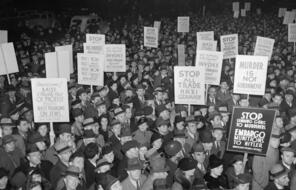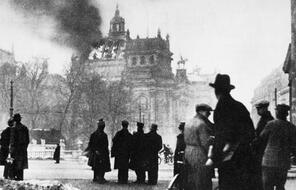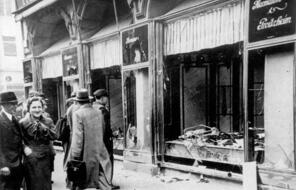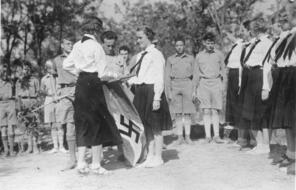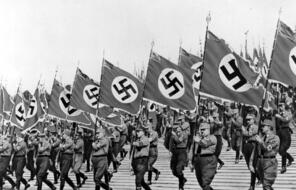The War on Jews in Poland
Subject
- History
Language
English — USUpdated
Hitler's Ideology: Race, Land, and Conquest
The German invasion of Poland was devastating not only for Poles but also for the more than 3.5 million Jews who lived there in 1939. In Germany, Jews were about 1% of the population; in Poland they made up 10%, and the proportion of Jews was often much higher in Polish cities such as Warsaw. In the first few days of the invasion, Jacob Birnbaum discovered how he and his fellow Jews would be affected by German occupation:
On Tuesday, September 5, at 4:00 in the afternoon, German ground troops entered [the town of] Piotrkow and conquered the city after two hours of street fighting. That same day they set out on a search for Jews in the almost deserted city, found twenty, among them Rabbi Yechiel Meir Fromnitsky, and shot them in cold blood. Thus it began.
The next day, September 6, the Germans set fire to a few streets in the Jewish quarter and shot Jews trying to escape from their burning homes. . . . Both individually and in groups the Germans invaded the Jewish community and stole virtually everything they feasibly could—clothes, linen, furs, carpets, valuable books. They often invited the Poles on the streets to take part in the looting, after which they would fire bullets into the air to give the impression that they were driving away the Polish “thieves.” These scenes were photographed by the Germans to demonstrate for all that they were protecting Jewish property from Polish criminals.
Jews, many of them elderly, were kidnapped and sent to forced labor camps where they were tortured and beaten—often to the point of loss of consciousness. These kidnappings took place during the days preceding Rosh Hashanah [the Jewish new year], as well as on the holy day [Yom Kippur] itself. Jewish men hid themselves in cellars, attics, and elsewhere, yet most were caught. The worst fate was that of the Jews sent to the SS Precinct. The main objective of the work there was torture, not productivity. Jews were forced, for instance, to do “gymnastics” while being beaten and subjected to various other forms of humiliation. . . .
One common insult suffered by the Jews during the early days under the new regime was their being chased away or beaten as they tried to wait in line for food together with other citizens. All Jews who attempted to resist were gunned down immediately.
During the holy days of Rosh Hashanah, as Jews hurriedly gathered to pray in the synagogues and private homes, still more torture was inflicted upon them. Several German officers entered the Great Synagogue stirring up much confusion among the worshipping Jews, many of whom attempted to escape. Twenty-nine worshippers were beaten brutally and taken away to prison, among them the lay leader of the congregation. The news of this event spread rapidly through the city, causing a great deal of fright, consternation, and anxiety. There were no worshippers in the synagogue on the second day of Rosh Hashanah.
Two days before Yom Kippur [the Jewish day of atonement], German officers and troopers entered the shut synagogue, broke up the furnishings, and completely demolished the beautifully ornamented eastern wall. 1
As the fighting in Poland continued, Reinhard Heydrich, the chief of the Reich Central Security Office, called a meeting in Berlin of the leaders of several SS units known as the Einsatzgruppen (mobile killing squads made up primarily of German SS and police personnel). At the meeting, Heydrich distinguished between “the final aim (which will require extended periods of time)” and “the stages leading to the fulfillment of this final aim (which will be carried out in short periods).” He began by ordering that Jews be forcibly moved from the countryside to large cities. Jewish communities with less than 500 persons were to be dissolved and their residents transferred to the nearest “concentration center.”
By the end of 1939, all Jews in occupied Poland aged ten and above had to wear yellow stars on their sleeves to indicate that they were Jews. Jewish-owned shops had to display signs in their windows. Also, Jews could be treated only by Jewish physicians. 2 Failing to obey these or any of the other laws the Nazis imposed could mean ten years in prison. The Germans established at least 1,100 ghettos and hundreds of forced labor camps in occupied Poland. Historian Richard Evans writes that in the General Government, “if Poles were second-class citizens, then Jews scarcely qualified as human beings at all in the eyes of the German occupiers, soldiers and civilians, Nazis and non-Nazis alike.” 3
Connection Questions
- What questions do you have about the individual stories in this reading? What stood out to you the most?
- What does Jacob Birnbaum’s description of the events in Piotrkow tell you about Nazi policy in Poland?
- The Nazis enacted measures to isolate Jews in Germany over the course of six years, but in 1939 they isolated Jews in Poland in just a few months. What measures did they take to isolate Jews in Poland? What might have been the impact of implementing those measures so quickly?
How to Cite This Reading
Facing History & Ourselves, “The War on Jews in Poland”, last updated August 2, 2016.

